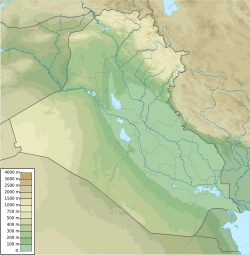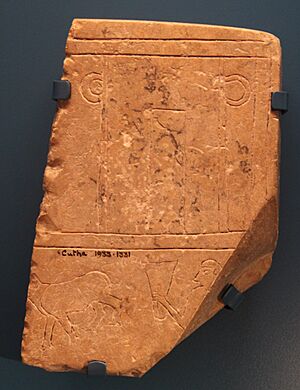Kutha facts for kids
|
Kutha
|
|
| Lua error in Module:Wikidata at line 70: attempt to index field 'wikibase' (a nil value). | |
| Alternative name | Cuthah |
|---|---|
| Location | Babil Governorate, Iraq |
| Region | Mesopotamia |
| Coordinates | 32°45′36.1″N 44°36′46.3″E / 32.760028°N 44.612861°E |
| Type | tell |
| Site notes | |
| Excavation dates | 1881 |
| Archaeologists | Hormuzd Rassam |
Kutha, also known as Cuthah or Cutha, is an ancient city site in modern-day Iraq. Today, it's called Tell Ibrahim. This important archaeological site is located in the Babil Governorate. It was a busy city for a very long time, from the Old Akkadian period all the way to the Hellenistic period. The main god worshipped in Kutha was Meslamtaea, who was connected to the god Nergal. His temple in the city was called E-Meslam.
Contents
Exploring Ancient Kutha
Kutha is found on the right side of the eastern branch of the Upper Euphrates river. It's north of Nippur and about 25 miles northeast of the ancient city of Babylon. The site has two main mounds, which are like hills made from layers of old settlements.
The larger mound is shaped like a crescent moon and is about 0.75 miles long. A smaller mound sits to the west, inside the curve of the crescent. These two mounds are separated by the dry bed of an old canal. This canal was likely the Shatt en-Nil or possibly the Irninna, and it would have brought water from the Euphrates river.
First Discoveries
The first person to look closely at the site was Henry Rawlinson in 1845. He found a brick from King Nebuchadrezzar II of the Neo-Babylonian Empire that mentioned Kutha. He visited the site many times. Other explorers like George Smith and Edgar James Banks also came to see Kutha.
Excavations by Hormuzd Rassam
In 1881, Hormuzd Rassam led an excavation at Tell Ibrahim for four weeks. He didn't find a huge amount, but he did uncover some bowls with writings in Hebrew and Aramaic, along with a few clay tablets. He also found a neglected "mausoleum of Abraham" on the smaller mound and had his workers clean it up. Rassam noted more bricks from Nebuchadrezzar II but wasn't sure if they originally came from this exact spot.
Most ancient texts found at the site are from the Achaemenid period. However, a few are from the older Old Akkadian period and one from the Old Babylonian period.
Kutha Through History
Kutha has a long and interesting history, mentioned in many ancient writings.
Early Mentions
Around 2200 BC, an inscription from Naram-Sin of Akkad mentions Kutha. After several cities rebelled against him, Naram-Sin declared himself a god. The inscription says:
"Naram-Sin, the mighty, king of Agade, when the four quarters together revolted against him, through the love which the goddess Astar showed him, he was victorious in nine battles in one in 1 year, and the kings whom they (the rebels[?]) had raised (against him), he captured. In view of the fact that he protected the foundations of his city from danger, (the citizens of his city requested from Astar in Eanna, Enlil in Nippur, Dagan in Tuttul, Ninhursag in Kes, Ea in Eridu, Sin in Ur, Samas in Sippar, (and) Nergal in Kutha, that (Naram-Sin) be (made) the god of their city, and they built within Agade a temple (dedicated) to him. ..."
A special tablet found in Nineveh tells us that Shulgi, the second ruler of the Ur III empire, built the E-Meslam temple for the god Nergal in Kutha. This happened early in his reign. The tablet states:
"Sulgi, the mighty, king of Ur and of the four quarters, builder of E-meslam ("House, Warrior of the Netherworld"), temple of the god [N]ergal, his lo[rd], in [Kuth]a."
During Shulgi's time, a large palace was built at Tummal. Materials for this palace came from many places, including Kutha.
Babylonian Rule
In the early Old Babylonian period, a ruler named Ilum-nāsir governed Kutha. Later, Sumu-la-El, a king of the 1st Babylonian Dynasty, rebuilt the city walls of Kutha.
The famous king Hammurabi of Babylon defeated Kutha in the 39th year of his rule. His year name for that time says: "Year in which Hammu-rabi the king with the great power given to him by An and Enlil smote the totality of Cutha and the land of Subartu". The next year, Hammurabi's year name mentions the Emeslam temple in Kutha again.
Later Empires
Around 1200 BC, a ruler from the Kassite dynasty named Adad-shuma-usur mentioned Kutha in his writings. He spoke of visiting the city and its temple.
The Black Obelisk of Shalmaneser III, a Neo-Assyrian monument from 859–824 BC, also mentions Kutha. It records that King Shalmaneser III made sacrifices in important cities, including Kutha.
Later, in 651 BC, the Neo-Assyrian ruler Ashurbanipal recorded that Šamaš-šuma-ukin captured Kutha. Šamaš-šuma-ukin was the brother of Ashurbanipal.
An inscription from the Neo-Babylonian ruler Nebuchadnezzar II (605-562 BC) also talks about Kutha. He mentions providing many offerings for the gods Nergal and Las at the Emeslam temple in Kutha.
Under Persian and Greek Control
Kutha was also under the control of the Achaemenid Empire ruler Cyrus the Great from 539–530 BC. We know of several governors from this time, including Nergal-tabni-usur.
Later, during the time of the Diadochi Chronicle (after Alexander the Great's empire split), Kutha is mentioned again. In 311/310 BC, a general named Antigonus I Monophthalmus fought against Seleucus I Nicator. The temple administrator of Kutha was involved in this conflict.
Kutha in Religious Stories
Kutha is important in several religious traditions and ancient stories.
The Legend of the King of Cuthah
There's an ancient story called the "Legend of the King of Cuthah." It's part of a larger story known as the "Cuthean Legend of Naram-Sin." This story is not meant to be a historical record but a literary work. A copy of it was found in an ancient library at Sultantepe.
In the Hebrew Bible
According to the Tanakh (the Hebrew Bible), Kutha was one of the cities from which Sargon II, the King of Assyria, brought people to live in the land of the exiled Israelites. This is mentioned in 2 Kings 17:24-30. The Bible says that these new settlers were attacked by lions. They believed this meant their worship wasn't pleasing to the local god. So, they asked Sargon to send an Israelite priest to teach them. This led to a mix of religions and peoples. These people were later known as "Cuthim" in Hebrew and "Samaritans" to the Greeks.
In Islamic Tradition
Some Islamic traditions also mention Kutha. Ibn Sa'd, a historian, wrote that Abraham's maternal grandfather, Karbana, discovered the river Kutha.
Al-Tabari, another historian, wrote in The History of Prophets and Kings that the prophet Ibrahim's mother was Nuba or Anmatala. She was the daughter of Karita, who dug the river Kutha, which was named after his father, Kutha.
Some Shiite Muslims believe Kutha is the original home of Abraham, connecting it to the roots of Islam.
See also




